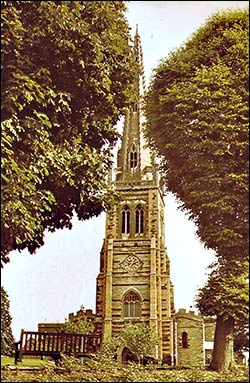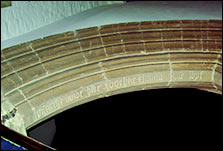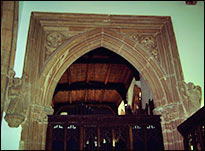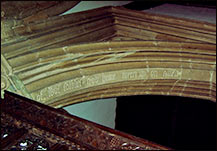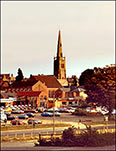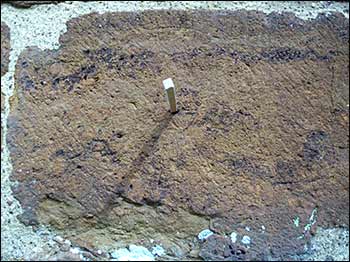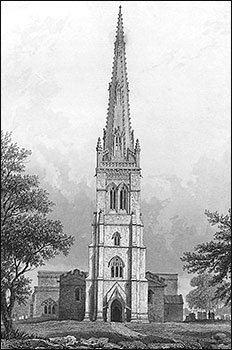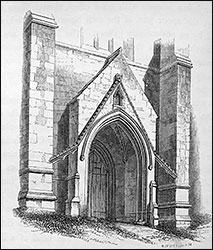St. Mary’s, the parish church of Rushden is situated at the southern end of the town opposite the green. In its elevated position it stands as a fine example of architecture in a county noted for its churches.
The Domesday Book records that ‘a virgate of land was held in Rushden that was formally held with power of sale by Samar the Priest’ so there may have been a church but there is no mention of one which, if it existed, was probably a small insignificant wooden building. The foundations of the original Norman church are still beneath the present one and it seems to have been a simple rectangular building 13ft x 16 ½ ft. There are no records of the church or names of the priests before 1230.
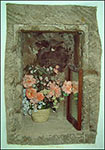 |
|
An Aumbry
|
|
Between 1250 & 1270 the church was extensively extended. A tower and the chancel were built and both North and South aisles in the Early English style were added. The previous north and south walls were replaced by arcades also probably in the same style. The next addition was the North Transept which was built about 1300 on the outside of which is a blocked doorway which originally led to the chapel of St. John housed in the North Transept. On the east wall of the North Transept are two recesses in the wall which appear to have had doors and might have been Aumbrys (cupboards which were originally used to store chalices and other vessels). Later, in the 14th century the South Transept was built, at the same time the tower was enlarged and strengthened and the spire, which is 172ft high, was built. The crockets on the side are there so that the steeplejacks could use them to climb up and carry out repairs. |
|
| Both the North and South Porches were also constructed. The North Porch has an empty niche and a room over the top which has an original fireplace and window. It was initially approached by an outside wooden staircase which has now gone. The room has been used at various times as a priest’s lodging, a hermit’s cell, a school and, in 1850, as a home for an elderly woman. Outside the North Porch stands a large dressed stone reputedly to be the stone of sanctuary but more probably is the base of a holy water stoup. |
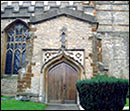 |
|
The North Porch
|
|
|
On the outside west wall of the South Transept can be seen a high window through to the South Transept which was blocked up although it is not known why.
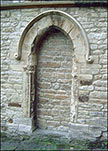 |
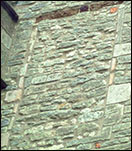 |
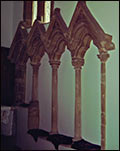 |
|
Blocked Doorway
|
Blocked window
|
Sedilia and Piscina
|
|
Inside the Chancel, on the south side, there is an Early English Piscina (for washing the chalice and paten during Mass) and a Sedilia (seats for the priest and assistants). On the South Wall is another well preserved Piscina. Towards the end of the century the transept roofs were raised.
 |
|
The Font
|
|
The stone Font is 14th century and the carving is a mixture of Early English and Decorated styles. The oak Pulpit is one of only thirty five 14th century pulpits left in England constructed in the time of Wycliffe (John Wycliffe translated the bible into English in 1380). |
 |
|
The Pulpit
|
|
Dividing the vestry from the nave aisle is an oak screen and the ‘Bochar Arch’. This is in perpendicular style and there is an inscription which reads ‘This arch made Hwe Bochar and Julian hise wyf, of whos sowlus God have merci up on amen’. In the Rushden Court Rolls dated 30th April 1404 it reads ‘Hugh Bocher sued William Duke for 16 shgs., the price of a horse sold to him. Duke says he does not owe anything because he took the horse for the service of the King in the war against the Welch when he was constable of Rushden and he asked for the verdict of a jury’. A jury was summoned and on 8th June 1404 decided that ‘Hugh Bocher should recover 16 shgs., against William Duke’.
| The carved Rood Screen is 15th Century and between 1470 and 1490 the last extensive rebuilding took place leaving the building largely as it is seen today. The chancel aisle walls were raised with arched roofs and Perpendicular windows. The nave piers and chancel arcade were rebuilt in the Perpendicular style and it is likely that the clerestory also dates from this time. Later, the beautiful timber roofs were erected. The Angel Roof has finely carved angels holding a variety of musical instruments. |
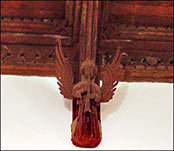 |
|
The Angel Roof
|
|
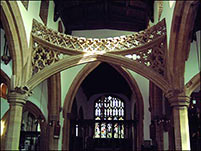 |
|
The Strainer Arch
|
|
At this time the strainer arch was inserted in order to prevent the nave walls from falling together. This beautiful arch is a very rare feature and is one of only four examples of this type of architecture known in England. Up until the 19th Century the arch was choked with whitewash, the original stone being finally exposed after curate, Rev. F.M. MacCarthy painstakingly uncovered it by hand. |
In 1541 the Diocese of Lincoln was split and the Diocese of Peterborough set up. Rushden, together with most of Northamptonshire was included in the new diocese. During the 16th century many statues inside and outside the church were removed by zealous reformers and the walls whitewashed to cover the paintings. The stone altar was replaced by a wooden one.
By 1682 the church was in a very poor state and the rector, William Holmes, was ordered to ‘remove and take away rubbish round the church and chancel, to mend the glass in the church windows and keep out the pigeons. The seats in the chancel to be mended and the communion rails to be set up. To change the old silver paten for one which will hold a large penny loaf. To buy a new cushion for the pulpit and a new carpet for the communion table of green cloth at 14 pence per yard with green silk fringe 3 inches deep’.
In 1794 a peal of five bells was cast and set up as a scale and in 1818 a great tenor bell added. At this time a bell was rung daily at noon; a Pancake bell on Shrove Tuesday; a gleaning bell during harvest time; a death knell of three tolls for a man and two for a woman. A bell was also rung at day break after a wedding to wake the bride for her household duties.
In 1847 efforts were made to improve the state of the church which was again in a poor state. The floors, seats, communion table and pulpit were repaired. Later, under Canon Barker £6000 was spent in restoration (1875) of the church and in 1879 a new clock was installed. The choir stalls date from 1870 but there is a 14th century miserere chair which has been preserved.
